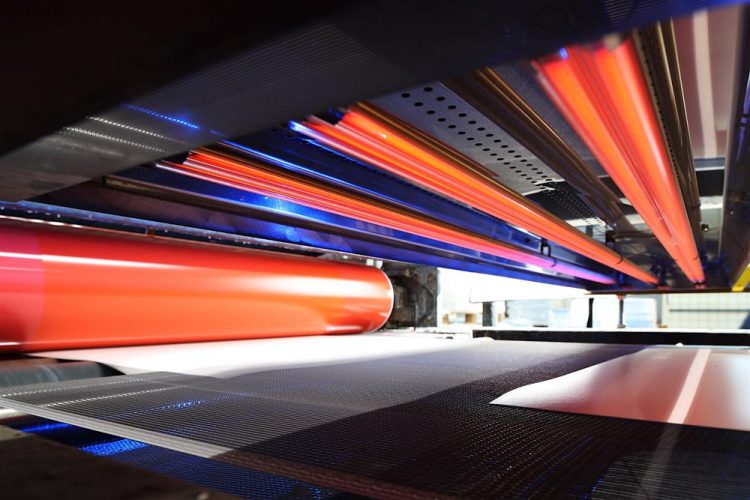Innovative Infrared heat reduces energy consumption in coating packaging for food

An infrared system from Heraeus Noblelight has dramatically reduced energy costs in the coating of board for food packaging. Copyright Heraeus Noblelight 2018
An infrared system from Heraeus Noblelight has dramatically reduced energy costs in the coating of board for food packaging at the Stroud factory of The Olympic Varnish Company Ltd. By eliminating the use of steam, the new system has also reduced board spoilage caused when there are unanticipated line stoppages.
Heraeus Noblelight will present innovative infrared solutions for drying, curing and converting at the ICE exhibition, which takes place in Munich in March 2019.
Infrared heat replaces hot steam
Olympic Varnish coats a variety of packaging for food products, ranging from sandwiches, cakes and patisserie to fish and pizza. Polymer coatings are applied to act as a double barrier, preventing any seepage or migration of grease or liquid components of the food from inside the packaging or any leeching of materials, which might taint the product into the packaging. The company also applies pigment and/or print to the outside of packaging if required.
The coater line at Stroud has three coating stations and these are used to apply the polymer coats, or pigment coats if necessary. It is important that the board is dried after each coating and previously this had been done by means of steam-heated, hot air driers in the coating line.
However, this was very energy-intensive, as the driers had to be kept at temperature throughout each working shift. In addition, if there was a line stoppage, they could not be switched off and so continued to heat any boards held within the driers, leading to product damage.
To solve these problems, it was decided to use infrared for drying and three 7kW carbon medium wave modules were easily retrofitted before each drier. There was no need to remove the driers and today these are merely supplied with ambient, unheated air.
The new IR drying system has been eminently successful, as Bill Petyan, director at the company, confirms, “We now have more flexibility in coating as the IR heaters can be quickly switched on and off, significantly reducing energy costs.
We can also tailor the amount of energy we need as the IR modules typically run between 30% and 60% of full load, depending on the type of board and the weight of coating. In addition, we have also installed a system to detect unwanted build-up of boards on the line when this quickly switches off the heaters”.
Infrared heat saves energy
Infrared radiation heats the material precisely and efficiently. In contrast to conventional heating infrared heat is transferred without the need of a contact medium like steam or air.
Infrared modules are supplied ready-to-fit and can be integrated directly into the production process. Quick response times allow control of the emitters and help to save heating time, energy and costs.
Heraeus specialises in the production and application of high quality energy sources covering the electro-magnetic spectrum from ultraviolet to infrared. It has over 40 years of experience in infrared technology and offers the expertise, products and systems to provide efficient and effective solutions to drying, heating and curing problems throughout industry.
A globally leading technology group, Heraeus is headquartered in Hanau, Germany. Founded in 1851, it is a family-owned portfolio company which traces its roots back to a pharmacy opened by the family in 1660. Today, Heraeus combines businesses in the environmental, energy, electronics, health, mobility and industrial applications sectors.
In the 2017 financial year, Heraeus generated revenues of €21.8 billion. With approximately 13.000 employees in 40 countries, the FORTUNE Global 500-listed company holds a leading position in its global markets. Heraeus is one of the top 10 family-owned companies in Germany.
With technical expertise, a commitment to excellence, a focus on innovation and entrepreneurial leadership, we are constantly striving to improve our performance. We create high-quality solutions for our clients and strengthen their long-term competitiveness by combining unique material expertise with leadership in technology.
Heraeus Noblelight GmbH with its headquarters in Hanau and with subsidiaries in the USA, Great Britain, France and China is one of the technology- and market-leaders in the production of specialty light sources and systems. In 2017, Heraeus Noblelight employed 762 people worldwide. The organization develops, manufactures and markets infrared and ultraviolet emitters, systems and solutions for applications in industrial manufacture, environmental protection, medicine and cosmetics, research, development and analytical measurement techniques.
Further information:
Technical: Heraeus Noblelight GmbH
Reinhard-Heraeus-Ring 7
D-63801 Kleinostheim
Tel +49 6181/35-8545, Fax +49 6181/35-16 8545
E-Mail hng-infrared@heraeus.com
Press: Dr. Marie-Luise Bopp
Heraeus Noblelight GmbH,
Tel +49 6181/35-8547, Fax +49 6181/35-16 8547
E-Mail marie-luise.bopp@heraeus.com
Media Contact
All latest news from the category: Trade Fair News
Newest articles

NASA: Mystery of life’s handedness deepens
The mystery of why life uses molecules with specific orientations has deepened with a NASA-funded discovery that RNA — a key molecule thought to have potentially held the instructions for…

What are the effects of historic lithium mining on water quality?
Study reveals low levels of common contaminants but high levels of other elements in waters associated with an abandoned lithium mine. Lithium ore and mining waste from a historic lithium…

Quantum-inspired design boosts efficiency of heat-to-electricity conversion
Rice engineers take unconventional route to improving thermophotovoltaic systems. Researchers at Rice University have found a new way to improve a key element of thermophotovoltaic (TPV) systems, which convert heat…



